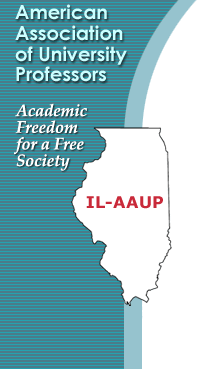Home | IL Academe | About IL AAUP | Conference Corner | Calendar | Services | Committees | Contact Us | Grants | Reports | Links
 |
 |
 |
Academe brings faculty the latest news and thought-provoking commentary
The May–June issue of Academe tackles the complex issues of media coverage of higher education, the public’s perception of academe, and the role that conservative think tanks and foundations play in both affecting media coverage of higher education and reconfiguring higher education itself. Faculty members are losing a critical battle for the soul of America. And we’re losing it partly, but significantly, because we’ve lost the media, if we ever “had” them. We tend to denigrate them, and they don’t like us so much either. It gets worse. The media themselves are on life support, as newsrooms downsize. And are we to follow not long after? The metaphors comparing higher education to Detroit are proliferating. What to do? For starters, take media coverage of higher education seriously. Dane S. Claussen, author of Anti-intellectualism in American Media, does a retake on his book and realizes that the core functions of higher education—teaching, learning, researching, thinking, debating, studying, and writing—often get short shrift in the media. Jon Marcus, US correspondent for the United Kingdom’s Times Higher Education magazine, suggests that the great divide between faculty and the media can be bridged. Those thoughtful journalists who remain could use the help of committed faculty members. Alice Sunshine, communications director for the California Faculty Association, is in agreement: “earned media”—which comes from committed faculty members working with journalists—can affect policy and change the public’s perception. But it isn’t straightforward. Eric Alterman, columnist for The Nation and journalism professor at CUNY and Brooklyn College, writes about how the collapse of newspapers has fueled the rise of ideological misinformation. Holly Yettick, a former education reporter, finds that “advocacy-oriented think-tank studies” get disproportionate media attention. And Marybeth Gasman of the University of Pennsylvania and Nelson Bowman III of Prairie View A&M University argue that media portrayals of HBCUs are not always accurate. They can—and should—be challenged and changed. Barry Yeoman, called by Columbia Journalism Review one of “the best unsung investigative journalists working in print in the United States,” reports on a separate, but critical, topic—the high price of for-profit colleges. And AAUP president Cary Nelson provides a compelling list of thirty ways to leave your institution in better shape than it is now. When long-time readers receive their copy of Academe in the mail, they may notice that we’ve updated the design. As always, we welcome your feedback. Respond to Academe articles or to our new design using the comment function on our website, or write to academe@aaup.org.
|
|